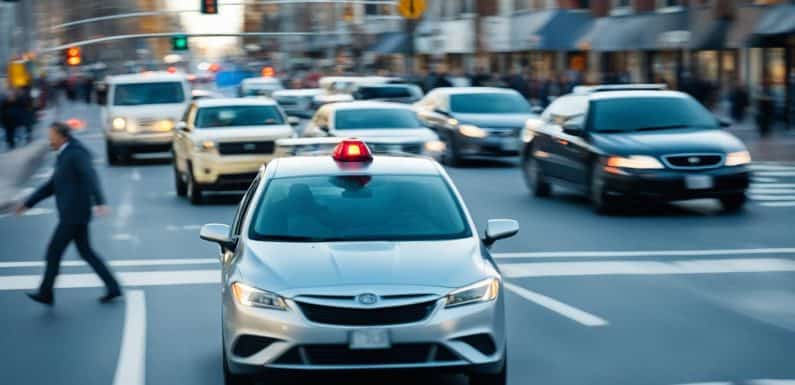
When a pedestrian violates traffic laws by walking into the street unexpectedly, drivers have clear Duties on the road to ensure safety. The immediate responsibility is to react calmly and avoid a collision, regardless of the pedestrian’s actions. Understanding and Responding to violations appropriately is not just courteous; it’s a legal must that can prevent accidents and save lives.
Key Takeaways
- Always be alert and ready to respond to unexpected pedestrian movements.
- Recognize that a pedestrian’s misstep does not exempt drivers from the responsibility to prevent harm.
- Comprehend your legal obligations and avoid escalating the situation.
- Adopt a proactive mindset by anticipating Pedestrian law violations and having a plan of action.
- Understand that appropriate Responding to violations is beneficial for the safety of all road users.
Why Yielding is the Responsible Choice for Drivers
In the dynamic environment of the road, unexpected incidents often arise that call for immediate driver responses. When pedestrians act unpredictably, yielding can be a decisive factor in accident prevention. Understanding the intricate dance between pedestrian behavior and vehicle maneuvering highlights why a cautious approach benefits all road users.
Legal Implications of Right of Way
The concept of right of way is grounded in both legal statutes and common courtesy. Legally, it determines who has the lawful authority to move first. However, when a pedestrian enters the street in violation of this principle, drivers are faced with a critical decision. Yielding in such situations isn’t just an ethical choice; it’s also a legal safeguard. By prioritizing safety over the strict legalities of right of way, drivers can avoid collisions and the accompanying legal complications that can ensue from accidents.
The Role of Defensive Driving
Defensive driving is a strategy encompassing a range of techniques and mindsets geared towards reducing the risk of harm on the road. One such technique involves recognizing the potential for error, not just in oneself, but also in other road users, including pedestrians. Yielding, even when it may not be legally required, is a defensive driving tactic that acknowledges the unpredictable nature of pedestrian behavior and prioritizes the well-being of all. This responsible choice encompasses anticipation and adaptation, as drivers must be prepared to alter their actions in the interest of preserving safety.
Pedestrian Behavior and Accident Prevention
Anticipating pedestrian behavior is tricky, but it is a crucial component of accident prevention. Even when pedestrians disregard traffic signals or cross in undesignated areas, drivers remain responsible for managing their vehicle’s response. A single moment of yielding can dramatically reduce the likelihood of an accident. By coupling a deep understanding of pedestrian tendencies with responsive driving practices, drivers contribute to a safer road environment, reinforcing the value of yielding as a protective measure against unforeseen incidents.
When a pedestrian walks out into the street in violation of the law, you should:
Dealing with pedestrian violations effectively requires a comprehension of the intertwined roles of legal standards, defensive driving techniques, and pedestrian behavior insights. Every driver has the potential to prevent accidents by adopting a proactive and informed approach to these unpredictable situations.
Legal Implications of Right of Way
Encountering a pedestrian violation can often result in confusion regarding the right of way. It’s essential to understand that despite pedestrians violating traffic laws, drivers are still legally obliged to avoid accidents where possible. This means that legal action could favor the pedestrian in some cases, due to the high duty of care expected from drivers. Legal implications might include penalties, fines, or even more severe consequences in the event of an incident.
The Role of Defensive Driving
Defensive driving stands as a cornerstone in accident prevention. When faced with a pedestrian stepping into traffic against signals or outside of a crosswalk, defensive driving strategies become invaluable. Techniques such as maintaining a safe following distance, understanding pedestrian cues, and being prepared to stop abruptly, can save lives. This anticipatory style of driving enables motorists to react calmly and efficiently to minimize risk on the roads.
Pedestrian Behavior and Accident Prevention
Understanding pedestrian behavior is an often overlooked but vital aspect of road safety. Pedestrians may act unpredictably due to distractions, impaired judgment, or a simple lack of awareness. Recognizing the signs of a potential pedestrian violation and knowing how to respond can significantly lead to accident prevention. Vigilance and patience play key roles in ensuring not only your safety as a driver but also the well-being of those on foot.

Enhancing Road Safety Beyond Traffic Laws
While adherence to traffic laws forms the bedrock of road safety, mitigating the hazards on our streets extends far beyond the confines of legal directives. A holistic approach to enhancing safety takes into account factors such as public awareness, infrastructure design, and community engagement, creating an interwoven safety net that guards every road user. Prominent initiatives aiming to bolster road safety often involve rigorous public education campaigns that focus on the shared responsibility between drivers and pedestrians, as well as on the risks of distracted and impaired driving.
On the front of infrastructure, strategic improvements have a profound impact. This entails incorporating safety features into the design and layout of roads. Recent studies support the idea that by implementing features like better lighting, dedicated pedestrian zones, traffic-calming measures, and advanced signalling technology, hazardous interactions can be significantly reduced. Such enhancements, paired with the existing framework of traffic laws, create an environment where precaution is seamlessly integrated into the daily commute.
Engagement within the community further solidifies the fabric of road safety. Local authorities and organizations can mobilize community members to advocate for safe driving practices and promote awareness of the importance of road safety. This includes school programs that educate young students, community workshops that update all residents on best practices, and collaborations with businesses to improve the areas around their premises. By taking these additional steps, the goal of enhancing safety amidst our thoroughfares becomes a tangible reality for every individual on the road.
